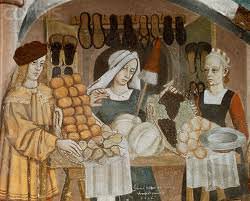CRISIS OF CONTRACTS FOR MERCHANTS IN CRISIS: INSTITUTIONS, CORPORATE FINANCE AND GROWTH IN GENOA (11TH -17TH C.)
Didier Joos de ter Beerst
Presented at the eighth Conference of the European Historical Economics Society (EHES) Geneva, September 4-5, (2009)
Abstract
I study Genoa’s economic rise and decline between 11th and 18th C. through the sequential and parallel evolution of its institutional regime and its financial system. Genoa’s economy went through two long-run expansion phases (roughly from 11th to late 13th C., and then from 16th to mid 17th C.) interrupted by about two centuries of decline and then stagnation. In its first expansion phase Genoa created a powerful loop between strong institutions and an efficient financial system allocating capital into distant ventures. Initially it was notaries drafting “commenda” contract (short-term equity) that provided an unsophisticated but critical tool to channel funds. From 13th C., a new model took place with emergence of Fairs, the rise of “merchant-bankers” and the “bills of exchange”. At that time, Genoa hosted a large community of foreign merchant-bankers and it was at the forefront of this revolution. But, the conflicts between aristocrats and “popolares” and rivalry between old incumbents undermined this model. Dozens of civil wars ravaged Genoa from 14th C. Many assets became under the control of a few incumbent family clans and Genoa’s financial system protracted.
Elsewhere in Europe, bankers and brokers started to replace notaries in international transactions, supporting innovations in debt, equity, and insurance products. By comparison, in Genoa in 14th C. most transactions remained drafted in Latin by notaries and many foreign bankers left the city. The outdated commenda remained in use throughout the 14th C. and early 15th C. Few long-term equity vehicles emerged (e.g. mahona, societatis) but it was “club-business” involving only few families controlling monopolies abroad. Genoese “insurances” drafted by notaries were in fact complex “fictive sales” or “fictive debt” aimed at hiding insurance premium (usury prohibition). After two centuries of decline and then stagnation, the comeback of Genoa in 16th C. was marked by a new institutional architecture (new republic in 1528), the reemergence of Genoa as the major financial center in the South and the return of Genoese merchant-bankers.
CRISIS OF CONTRACTS FOR MERCHANTS IN CRISIS: INSTITUTIONS, CORPORATE FINANCE AND GROWTH IN GENOA (11TH -17TH C.)
GENOA (11TH -17TH C.)
Didier Joos de ter Beerst
Presented at the eighth Conference of the European Historical Economics Society (EHES) Geneva, September 4-5, (2009)
Abstract
I study Genoa’s economic rise and decline between 11th and 18th C. through the sequential and parallel evolution of its institutional regime and its financial system. Genoa’s economy went through two long-run expansion phases (roughly from 11th to late 13th C., and then from 16th to mid 17th C.) interrupted by about two centuries of decline and then stagnation. In its first expansion phase Genoa created a powerful loop between strong institutions and an efficient financial system allocating capital into distant ventures. Initially it was notaries drafting “commenda” contract (short-term equity) that provided an unsophisticated but critical tool to channel funds. From 13th C., a new model took place with emergence of Fairs, the rise of “merchant-bankers” and the “bills of exchange”. At that time, Genoa hosted a large community of foreign merchant-bankers and it was at the forefront of this revolution. But, the conflicts between aristocrats and “popolares” and rivalry between old incumbents undermined this model. Dozens of civil wars ravaged Genoa from 14th C. Many assets became under the control of a few incumbent family clans and Genoa’s financial system protracted.
Elsewhere in Europe, bankers and brokers started to replace notaries in international transactions, supporting innovations in debt, equity, and insurance products. By comparison, in Genoa in 14th C. most transactions remained drafted in Latin by notaries and many foreign bankers left the city. The outdated commenda remained in use throughout the 14th C. and early 15th C. Few long-term equity vehicles emerged (e.g. mahona, societatis) but it was “club-business” involving only few families controlling monopolies abroad. Genoese “insurances” drafted by notaries were in fact complex “fictive sales” or “fictive debt” aimed at hiding insurance premium (usury prohibition). After two centuries of decline and then stagnation, the comeback of Genoa in 16th C. was marked by a new institutional architecture (new republic in 1528), the reemergence of Genoa as the major financial center in the South and the return of Genoese merchant-bankers.
Click here to read this article from the European Historical Economics Society
Subscribe to Medievalverse
Related Posts